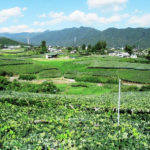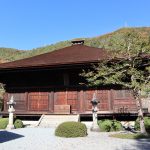

The Founding of Ichinomiya Asama Shrine
Founded on the 9th of December, 865, Ichinomiya Asama Shrine is the
second of two shrines, the first situated on the Shizuoka side of Mount
Fuji, built to contain and control the violent forces of the volcano after it
erupted over a two-year period. The eruption, which took place on the
northwest slope, caused a lava flow that buried many houses.
Interestingly, the flowing lava also split Lake Senoumi into present-day
Lake Shōji and Lake Sai. Over the past millennium, the Aokigahara Forest
(the sea of trees) has grown on top of the resulting lava field.
The Shrine’s Construction
Ichinomiya Asama Shrine’s entrance gate was built facing the direction of
Mount Fuji, but the iconic mountain cannot be seen from the gate as it was
decided at the time of construction to build the shrine at a safe distance
from its potentially violent eruptions. Furthermore, the main shrine building
was purposely built at a 90 degree angle to the entrance gate to protect
the goddess of the shrine (Konohanasakuya-hime), the goddess of Mount
Fuji, from taking a direct hit from any future eruptions.
“Omiyuki Festival”
Centuries ago, crops in the Kofu Basin were frequently damaged by the
flooding of the Kamanashi River. For this reason, on the 15th day of April,
an annual festival, with over 1100 years of history, is held to ask the
goddess of Ichinomiya Asama Shrine to protect the people of Yamanashi
from natural disasters over the coming year. Locals carry a mikoshi (an
elaborate portable shrine) to Ryūō Sansha Shrine in Kai City, which is
some 24 km to the west of this shrine, to allow the goddess of the shrine
to calm the god of the river. Furthermore, as the goddess of Ichinomiya
Asama Shrine resides within the mikoshi during the festival, it is traditional
for parents to seek the blessing of the goddess by passing under the
mikoshi with their newborn children. This festival is beloved by local
people and it has become common in modern times for those carrying the
mikoshi to be offered wine as they pass by well-wishers’ homes.
Offerings of Wine to the Goddess
It is a tradition throughout Japan for sake producers to offer their sake at
local shrines, however, as Ichinomiya Asama Shrine is located in the heart
of Japan’s wine country, wine has become the offering of choice. Over the
centuries, all types of local produce, including silk, has been offered by
those seeking blessings at this shrine, so it’s natural that wine should also
be offered. Hence, the shrine has been receiving 1.8-liter bottles of wine,
isshobin (which are typically used for sake), as offerings since the 1960s.



